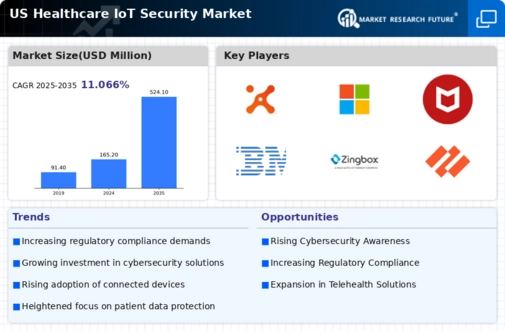Growing Patient Awareness
Patient awareness regarding data privacy and security is significantly influencing the healthcare iot-security market. As individuals become more informed about their rights and the risks associated with data breaches, they are demanding greater transparency and security from healthcare providers. Surveys indicate that over 70% of patients express concern about the security of their personal health information. This shift in consumer expectations is prompting healthcare organizations to enhance their security protocols and invest in advanced technologies to protect patient data. The increasing emphasis on patient-centric care and trust is likely to drive further growth in the healthcare iot-security market as providers seek to meet these evolving demands.
Integration of IoT Devices
The proliferation of Internet of Things (IoT) devices in healthcare settings is a key driver for the healthcare iot-security market. As hospitals and clinics increasingly adopt connected devices for patient monitoring, diagnostics, and treatment, the potential for security vulnerabilities rises. It is estimated that by 2026, the number of connected medical devices will exceed 50 billion globally, with a substantial portion in the US. This rapid integration necessitates comprehensive security frameworks to protect against unauthorized access and data breaches. Consequently, healthcare organizations are prioritizing investments in security solutions tailored to the unique challenges posed by IoT devices, thereby propelling growth in the healthcare iot-security market.
Rising Cybersecurity Threats
The healthcare iot-security market is experiencing heightened demand due to the increasing frequency and sophistication of cyberattacks targeting healthcare organizations. In recent years, the number of reported breaches has surged, with healthcare data breaches accounting for approximately 25% of all reported incidents. This alarming trend compels healthcare providers to invest in robust security measures to protect sensitive patient information and maintain compliance with regulations. As a result, the market is projected to grow significantly, with estimates suggesting a compound annual growth rate (CAGR) of around 15% over the next five years. The urgency to safeguard against these threats is driving innovation and investment in advanced security solutions within the healthcare iot-security market.
Regulatory Landscape Evolution
The evolving regulatory landscape surrounding data protection and cybersecurity is a significant driver for the healthcare iot-security market. Recent legislative measures, such as the Health Insurance Portability and Accountability Act (HIPAA) and the Health Information Technology for Economic and Clinical Health (HITECH) Act, have established stringent requirements for safeguarding patient information. Compliance with these regulations is not only mandatory but also critical for maintaining patient trust and avoiding hefty fines. As regulations continue to evolve, healthcare organizations are compelled to adopt comprehensive security strategies, thereby fueling growth in the healthcare iot-security market. The market is expected to see a surge in demand for compliance-focused security solutions as organizations strive to meet these regulatory requirements.
Technological Advancements in Security Solutions
Technological advancements in security solutions are playing a pivotal role in shaping the healthcare iot-security market. Innovations such as artificial intelligence (AI), machine learning (ML), and blockchain technology are being increasingly integrated into security frameworks to enhance threat detection and response capabilities. These technologies enable healthcare organizations to proactively identify vulnerabilities and mitigate risks associated with IoT devices. The market for AI-driven security solutions is projected to reach $20 billion by 2027, indicating a robust growth trajectory. As healthcare providers seek to leverage these advancements to bolster their security posture, the healthcare iot-security market is likely to witness substantial growth driven by the demand for cutting-edge security technologies.
























Leave a Comment